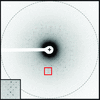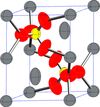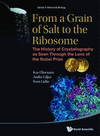issue contents
July 2015 issue

Cover illustration: A new technique for the imaging of ferroelectric domains via resonant X-ray diffraction from a single Bragg reflection is described by Fabrizi et al. [Acta Cryst. (2015), A71, 361-367]. The domain contrast is achieved through the energy dependence of the resonant scattering around an atomic absorption edge.
advances
scientific commentaries
Free 

A guide to the collection and processing of MicroED data invites X-ray crystallographers and electron microscopists to solve atomic structures from tiny protein crystals.
feature articles
Open  access
access
 access
accessThe collection and processing of MicroED data are presented.
research papers
Open  access
access
 access
accessThe identification and high-resolution mapping of the absolute crystallographic structure in multi-domain ferroelectric KTiOPO4 is achieved through a novel synchrotron X-ray diffraction method. On a single Bragg reflection, the intensity ratio in resonant diffraction below and above the Ti absorption K edge demonstrates a domain contrast up to a factor of ∼270, thus implementing a non-contact, non-destructive imaging technique with micrometre spatial resolution, applicable to samples of arbitrarily large dimensions.
foundations
research papers
Open  access
access
 access
accessA detailed and comprehensive theoretical description of X-ray diffraction moiré fringes for a bicrystal specimen is given on the basis of a calculation by plane-wave dynamical diffraction theory, where the effect of the Pendellösung intensity oscillation on the moiré pattern is explained in detail.
The number-theoretic concept of diaphony, as a measure of uniform distribution, is reviewed, highlighting its relation to crystallographic concepts like the largest interplanar spacing of a lattice, the structure-factor equation and the Patterson function.
This paper describes a method for unbiased peak extraction from atomic pair distribution functions using the information-theoretic Akaike information criterion.
A procedure for the approximation of viral capsids by icosahedral tilings is proposed and illustrated for a range of viruses from different families. The output tilings can be used as coarse-grained models of viral capsids, providing a basis for further mathematical modelling of their dynamic behaviour and assembly.
A closed-form method is developed to calculate correlation functions of arbitrarily stacked close-packed structures.
For investigation of the proton-disordered structure of clathrate hydrates, a new approach is presented which is based on topological crystallography.
Iterative projection algorithms are used to determine the structures of two tetrameric proteins starting with only a low-resolution envelope and the position of the non-crystallographic axes.
Temperature (20–300 K)- and energy-dependent phase shifts of resonant multiple-beam X-ray diffraction in germanium crystals, involving forbidden (002) and weak (222) reflections, are reported.
short communications
Some properties of the anisotropic displacement tensor have been revised. Complete tables for site-symmetry restrictions covering all special positions as listed in International Tables for Crystallography, Vol. A, are provided.
book reviews
Free 



 journal menu
journal menu































